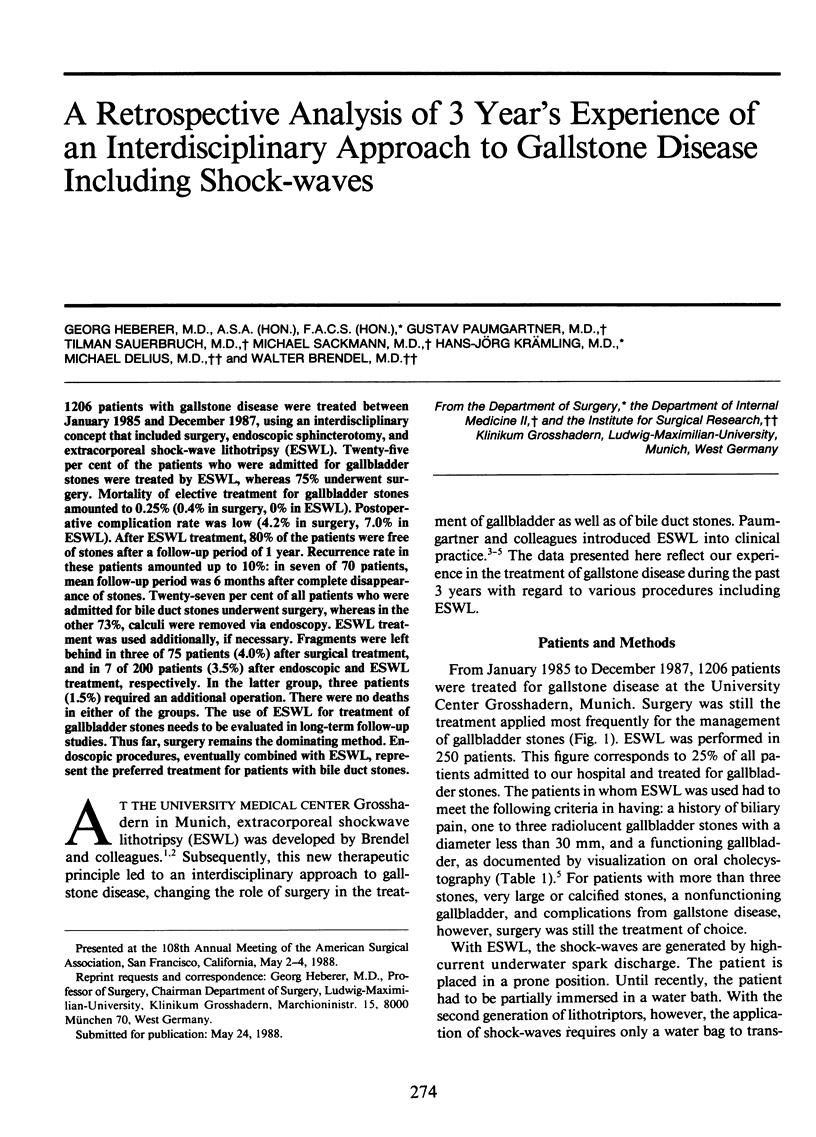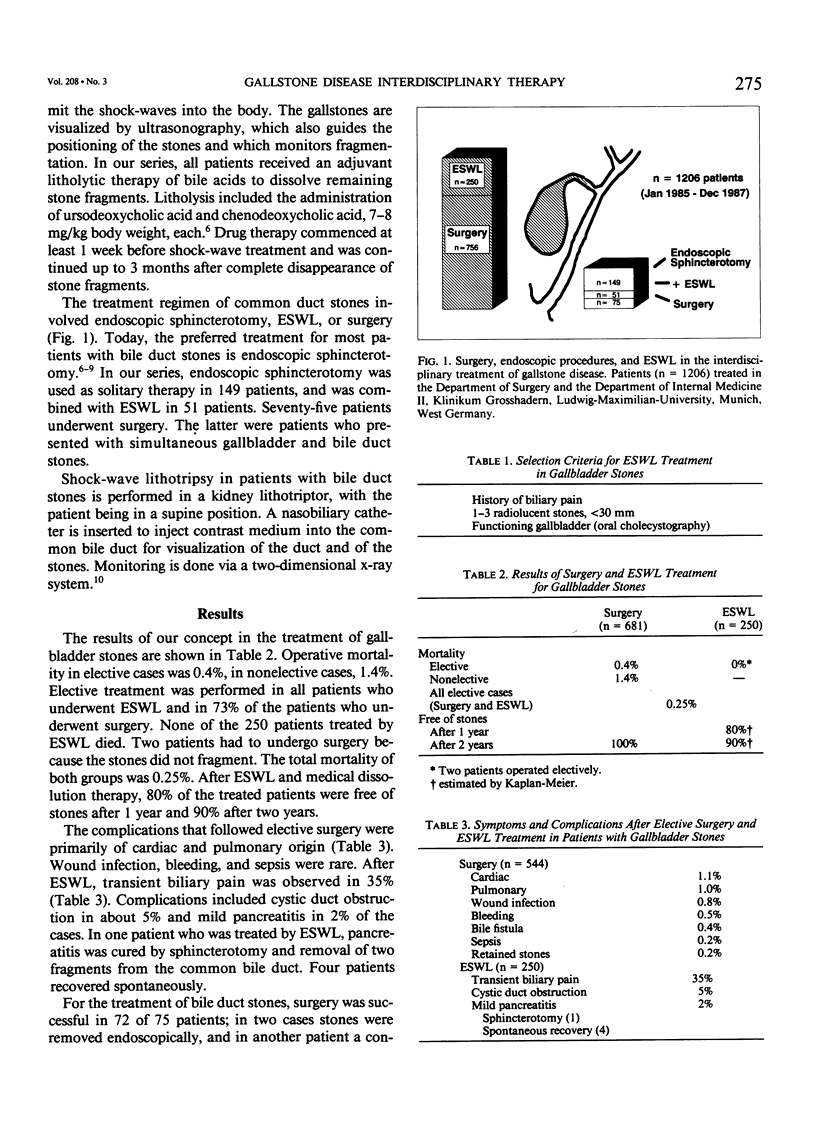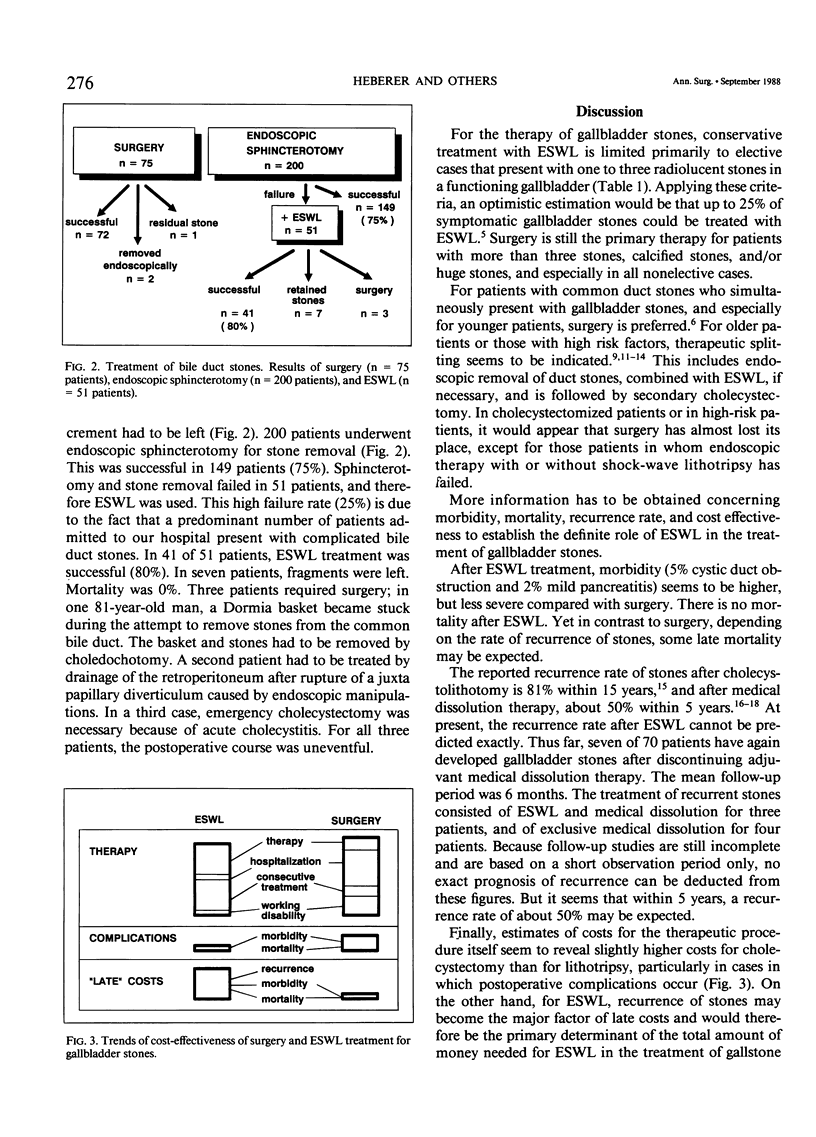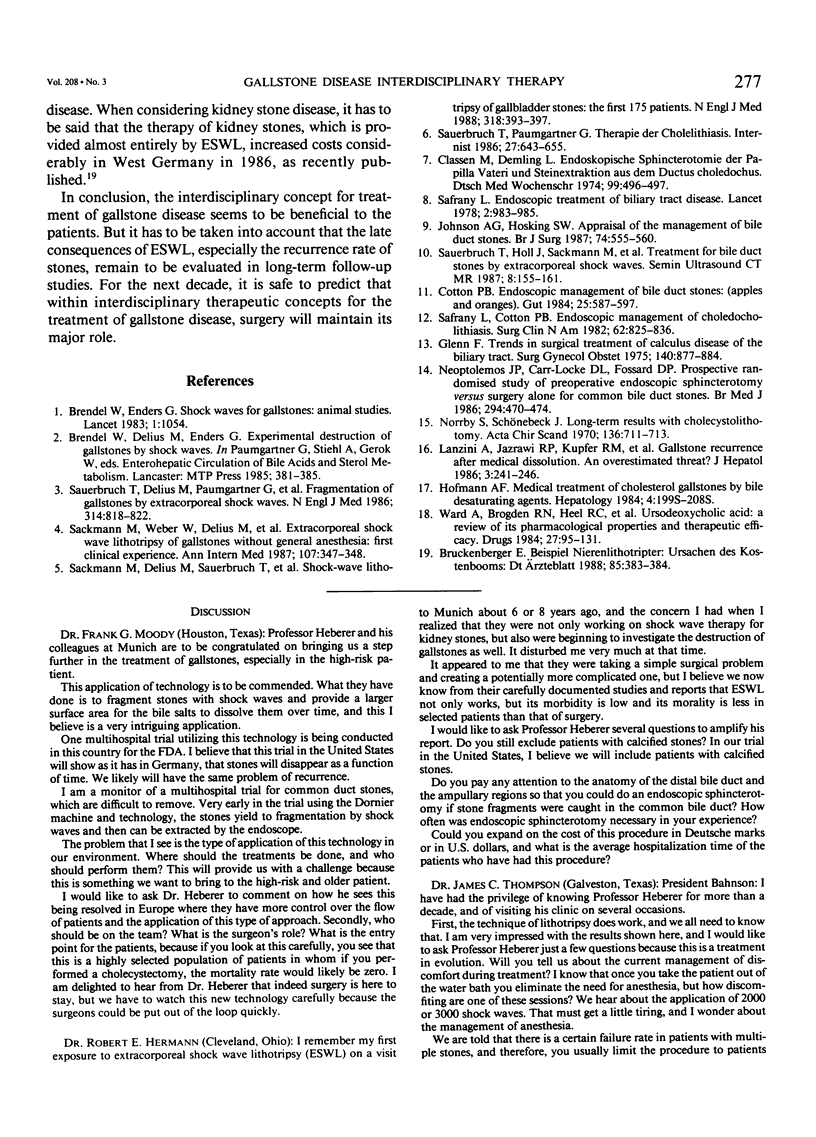Abstract
1206 patients with gallstone disease were treated between January 1985 and December 1987, using an interdisciplinary concept that included surgery, endoscopic sphincterotomy, and extracorporeal shock-wave lithotripsy (ESWL). Twenty-five per cent of the patients who were admitted for gallbladder stones were treated by ESWL, whereas 75% underwent surgery. Mortality of elective treatment for gallbladder stones amounted to 0.25% (0.4% in surgery, 0% in ESWL). Postoperative complication rate was low (4.2% in surgery, 7.0% in ESWL). After ESWL treatment, 80% of the patients were free of stones after a follow-up period of 1 year. Recurrence rate in these patients amounted up to 10%; in seven of 70 patients, mean follow-up period was 6 months after complete disappearance of stones. Twenty-seven per cent of all patients who were admitted for bile duct stones underwent surgery, whereas in the other 73%, calculi were removed via endoscopy. ESWL treatment was used additionally, if necessary. Fragments were left behind in three of 75 patients (4.0%) after surgical treatment, and in 7 of 200 patients (3.5%) after endoscopic and ESWL treatment, respectively. In the latter group, three patients (1.5%) required an additional operation. There were no deaths in either of the groups. The use of ESWL for treatment of gallbladder stones needs to be evaluated in long-term follow-up studies. Thus far, surgery remains the dominating method. Endoscopic procedures, eventually combined with ESWL, represent the preferred treatment for patients with bile duct stones.
Full text
PDF



Selected References
These references are in PubMed. This may not be the complete list of references from this article.
- Brendel W., Enders G. Shock waves for gallstones: animal studies. Lancet. 1983 May 7;1(8332):1054–1054. doi: 10.1016/s0140-6736(83)92687-9. [DOI] [PubMed] [Google Scholar]
- Classen M., Demling L. Endoskopische Sphinkterotomie der Papilla Vateri und Steinextraktion aus dem Ductus choledochus. Dtsch Med Wochenschr. 1974 Mar 15;99(11):496–497. doi: 10.1055/s-0028-1107790. [DOI] [PubMed] [Google Scholar]
- Cotton P. B. Endoscopic management of bile duct stones; (apples and oranges). Gut. 1984 Jun;25(6):587–597. doi: 10.1136/gut.25.6.587. [DOI] [PMC free article] [PubMed] [Google Scholar]
- Glenn F. Trends in surgical treatment of calculous disease of the biliary tract. Surg Gynecol Obstet. 1975 Jun;140(6):877–884. [PubMed] [Google Scholar]
- Hofmann A. F. Medical treatment of cholesterol gallstones by bile desaturating agents. Hepatology. 1984 Sep-Oct;4(5 Suppl):199S–208S. doi: 10.1002/hep.1840040837. [DOI] [PubMed] [Google Scholar]
- Johnson A. G., Hosking S. W. Appraisal of the management of bile duct stones. Br J Surg. 1987 Jul;74(7):555–560. doi: 10.1002/bjs.1800740703. [DOI] [PubMed] [Google Scholar]
- Lanzini A., Jazrawi R. P., Kupfer R. M., Maudgal D. P., Joseph A. E., Northfield T. C. Gallstone recurrence after medical dissolution. An overestimated threat? J Hepatol. 1986;3(2):241–246. doi: 10.1016/s0168-8278(86)80033-2. [DOI] [PubMed] [Google Scholar]
- Neoptolemos J. P., Carr-Locke D. L., Fossard D. P. Prospective randomised study of preoperative endoscopic sphincterotomy versus surgery alone for common bile duct stones. Br Med J (Clin Res Ed) 1987 Feb 21;294(6570):470–474. doi: 10.1136/bmj.294.6570.470. [DOI] [PMC free article] [PubMed] [Google Scholar]
- Norrby S., Schönebeck J. Long-term results with cholecystolithotomy. Acta Chir Scand. 1970;136(8):711–713. [PubMed] [Google Scholar]
- Sackmann M., Delius M., Sauerbruch T., Holl J., Weber W., Ippisch E., Hagelauer U., Wess O., Hepp W., Brendel W. Shock-wave lithotripsy of gallbladder stones. The first 175 patients. N Engl J Med. 1988 Feb 18;318(7):393–397. doi: 10.1056/NEJM198802183180701. [DOI] [PubMed] [Google Scholar]
- Sackmann M., Weber W., Delius M., Holl J., Hagelauer U., Sauerbruch T., Brendel W., Paumgartner G. Extracorporeal shock-wave lithotripsy of gallstones without general anesthesia: first clinical experience. Ann Intern Med. 1987 Sep;107(3):347–348. doi: 10.7326/0003-4819-107-2-347. [DOI] [PubMed] [Google Scholar]
- Safrany L., Cotton P. B. Endoscopic management of choledocholithiasis. Surg Clin North Am. 1982 Oct;62(5):825–836. doi: 10.1016/s0039-6109(16)42832-x. [DOI] [PubMed] [Google Scholar]
- Safrany L. Endoscopic treatment of biliary-tract diseases. An international study. Lancet. 1978 Nov 4;2(8097):983–985. doi: 10.1016/s0140-6736(78)92543-6. [DOI] [PubMed] [Google Scholar]
- Sauerbruch T., Delius M., Paumgartner G., Holl J., Wess O., Weber W., Hepp W., Brendel W. Fragmentation of gallstones by extracorporeal shock waves. N Engl J Med. 1986 Mar 27;314(13):818–822. doi: 10.1056/NEJM198603273141304. [DOI] [PubMed] [Google Scholar]
- Sauerbruch T., Paumgartner G. Therapie der Cholelithiasis. Internist (Berl) 1986 Oct;27(10):643–655. [PubMed] [Google Scholar]


